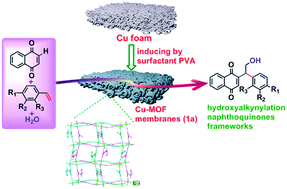Oriented assembly of copper metal–organic framework membranes as tandem catalysts to enhance C–H hydroxyalkynylation reactions with regiocontrol†
Abstract
Constructing well-organized metal–organic framework (MOF) membranes with a uniform and continuous nanoarchitecture is an effective strategy for the functionalization of MOF-based heterogeneous catalysts. In this work, by employing surfactant PVA (poly(vinyl alcohol)) as a soft-template, a moderate synthetic approach was adopted to obtain a Cu-MOF (1, [Cu(BBDC)(azobpy)(H2O)]n, H2BBDC = 4′-benzoyl-(1,1′-biphenyl)-3,5-dicarboxylic acid; azobpy = 4,4′-azopyridine) for building highly ordered Cu-MOF membranes (1a) with good control of the morphology and thickness on the surface of macroporous Cu foam, which could facilitate the growth of homogeneous and high-quality Cu-MOF membranes. Furthermore, the catalytic performance of Cu-MOF membranes 1a was superior to that of large sized 1 for tandem three-component C–H hydroxyalkynylation reactions, because the Cu-MOF membranes could afford a functionalized and tunable platform with the benefit of readily accessible active sites to promote tandem reactions by minimizing the diffusion distance but did little for their regioselectivity.



 Please wait while we load your content...
Please wait while we load your content...